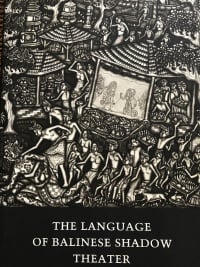Difference between revisions of "Book The Language of Balinese Shadow Theater"
From BASAbaliWiki
m (Alexey123 moved page The Language of Balinese Shadow Theater to Book The Language of Balinese Shadow Theater: Robot adding prefix) |
|||
| Line 1: | Line 1: | ||
| + | {{PageSponsor}} | ||
{{Book | {{Book | ||
|Name of Book=The Language of Balinese Shadow Theater | |Name of Book=The Language of Balinese Shadow Theater | ||
| Line 11: | Line 12: | ||
}} | }} | ||
|Author=Mary Sabina Zurbuchen, | |Author=Mary Sabina Zurbuchen, | ||
| − | |Subject=Wayang, Language, | + | |Subject=Wayang, Language, art, |
| + | |Linked words=Wayang, | ||
|Description text=Bali's shadow puppet theater, like others in Southeast Asia, is a complex tradition with many conventions that puzzle Western observers. Mary Zurbuchen demonstrates how the linguistic codes of this rich art form mediate between social groups, cultural influences, historical periods, and conceptual schemes. http://www.jstor.org/stable/j.ctt7zvpqd | |Description text=Bali's shadow puppet theater, like others in Southeast Asia, is a complex tradition with many conventions that puzzle Western observers. Mary Zurbuchen demonstrates how the linguistic codes of this rich art form mediate between social groups, cultural influences, historical periods, and conceptual schemes. http://www.jstor.org/stable/j.ctt7zvpqd | ||
Revision as of 05:34, 12 October 2020
- Title
- The Language of Balinese Shadow Theater
- Original language
- Author(s)
- Illustrator(s)
- Publisher
- Princeton University Press
- ISBN
- —
- Publication date
- July 14, 2014, originally published in 1987.
- Subjects
- Wayang
- Language
- art
- Find Book
- Related Env. Initiatives
- Related Places
- Related Biographies
- Related Children's Books
- Related Holidays
- Related Folktales
- Related Comics
- Related Lontar
- Linked words
Description(s)
"As the painting of a village shadow play that is reproduced on the dust jacket of this handsome book vividly illustrates, everything in Bali tends toward luxuriant complexity. Language is no exception: Balinese have long been inclined to take on other people’s languages and maintain them as distinct codes, available for use in specific contexts but never completely melded into a single entity one could call “Balinese.” So in the communicative thickets one finds: in everyday speech, an intricate system of speech registers indicating degrees of status and intimacy; in religious ritual, Sanskrit; in ritual and performances, Old Javanese; and increasingly, in official settings, the national language of Indonesian...."


Enable comment auto-refresher